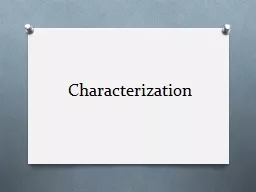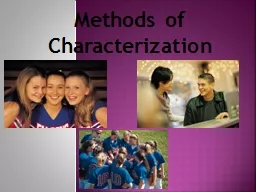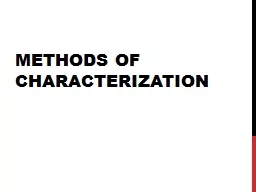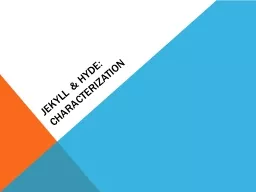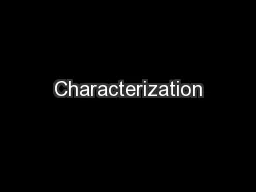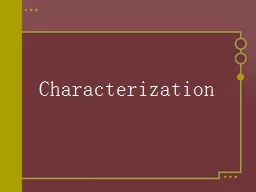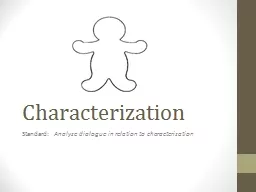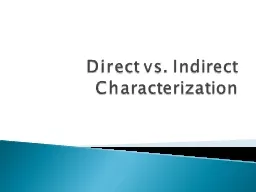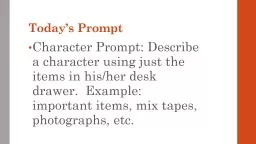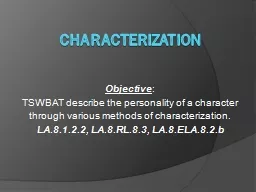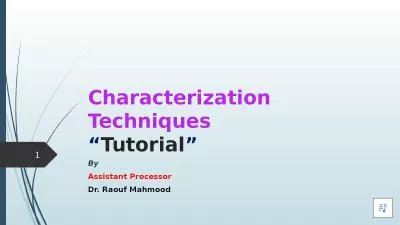PPT-Characterization
Author : natalia-silvester | Published Date : 2016-05-07
Two Main Types Direct Characterization Definition The author TELLS information about the character Example Samantha was sad Indirect Characterization Definition
Presentation Embed Code
Download Presentation
Download Presentation The PPT/PDF document "Characterization" is the property of its rightful owner. Permission is granted to download and print the materials on this website for personal, non-commercial use only, and to display it on your personal computer provided you do not modify the materials and that you retain all copyright notices contained in the materials. By downloading content from our website, you accept the terms of this agreement.
Characterization: Transcript
Two Main Types Direct Characterization Definition The author TELLS information about the character Example Samantha was sad Indirect Characterization Definition The author SHOWS information about the character This is often considered better writing . The process by which a writer reveals the personality of a character.. Two methods:. Direct characterization. Indirect characterization. Definition:. 1. Physical description of the character. Example:. Characterization. . – . the way an author reveals the special qualities and personalities of a character in a story, making the character believable. . Analyzing Character Traits. We try to figure out what a character in a book is like by paying attention to the clues the author gives us. This is called “. DIRECT. CHARACTERIZATION. The . Donkey . in the Lion's . Skin. One . day, . a donkey . found a . lion's . skin left in the forest by a hunter, and wishing to amuse himself and to feel powerful, put it on, scaring all the animals he met on his way. . Do Now. Honors/Warnings/Transitions. Complete self-evaluation.. Review as class & share comments. Do Now. Split into partners. Review active reading strategies. Name THREE things you might annotate for. . . Definitions. Characterization is the process by which the author reveals the personality of the characters. . There are two types of characterization: direct and indirect. . Direct Characterization . Characterization is the process by which the author reveals the personality of the characters. . There are two types of characterization: direct and indirect. . Direct Characterization . Direct characterization is when the author TELLS the audience what the personality of the character is. . Analyze dialogue in relation to characterization. HOW DOES HE LOOK?. “. Darry. is six feet two, and broad shouldered and muscular. He has dark-brown hair that kicks out in front and slight cowlick in the back…He’s got eyes that are like two pieces of pale blue like the rest of him. He looks older than twenty—tough, cool, and smart” (Hinton 6).. Direct Characterization. The author tells readers about characters by making direct statements about their personality. . Example: The quiet girl and her rambunctious brother strolled down the path to the beach.. Show the character’s appearance. Display the character’s actions. Reveal the character’s thoughts. Let the character speak. Get the reactions of others. Types of Characterization. Examples… . : . TSWBAT describe the personality of a character through various methods of characterization. . LA.8.1.2.2, LA.8.RL.8.3, LA.8.ELA.8.2.b. Characterization . is the way a writer reveals character.. What Is Characterization?. Take out your HW (. annotated. “Lamb to the Slaughter” and written analysis). . Pick any part of the story (a paragraph, a few paragraphs, one sentence, etc.) and draw a big box around it. . Then, on the back of your copy of the story, . “. Tutorial. ” . By. Assistant Processor . Dr. Raouf Mahmood. 1. Characterization techniques. Characterization techniques are classified as a . chemical characterization . and Structural characterization. (Ice Age) Beta Maturity. Cryosphere Products Validation Team. Jeff Key, NOAA/NESDIS/STAR, Team Lead. Paul Meade, Cryosphere Products JAM. DR # 7132. CCR # 474-CCR-13-0945. DRAT discussion: April 19, 2013. The author uses characterization to make his or her characters deeper and 3D.. By giving the character a personality, mentality, behavior, and mannerisms, the author makes the story and the character seem like they really exist..
Download Document
Here is the link to download the presentation.
"Characterization"The content belongs to its owner. You may download and print it for personal use, without modification, and keep all copyright notices. By downloading, you agree to these terms.
Related Documents

